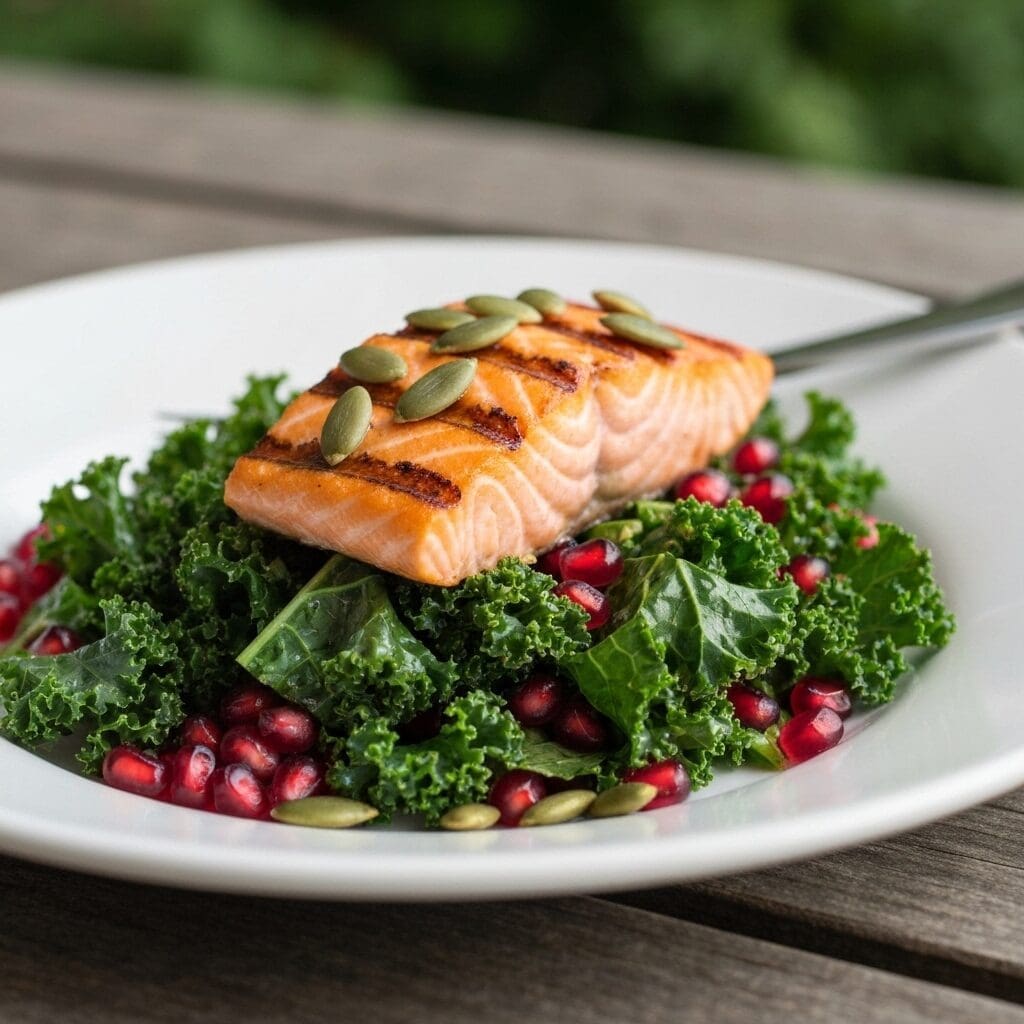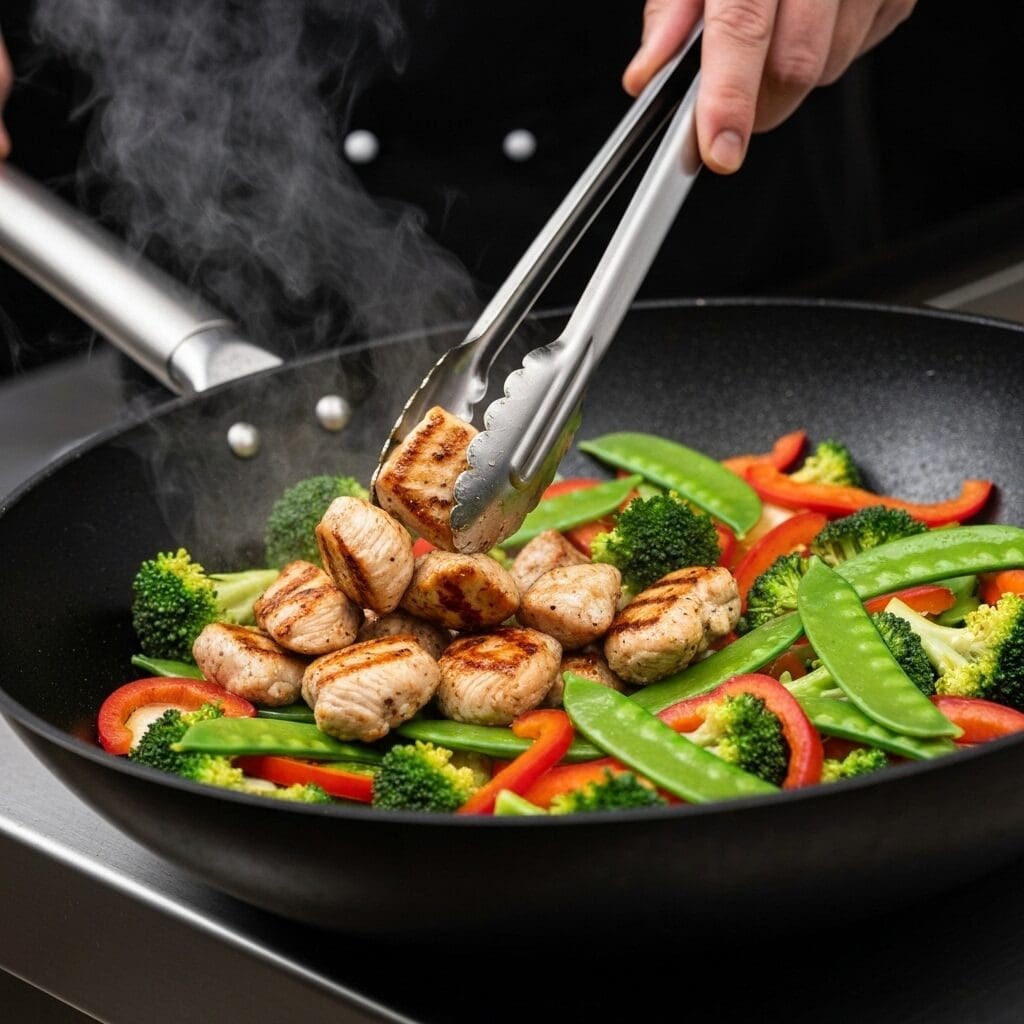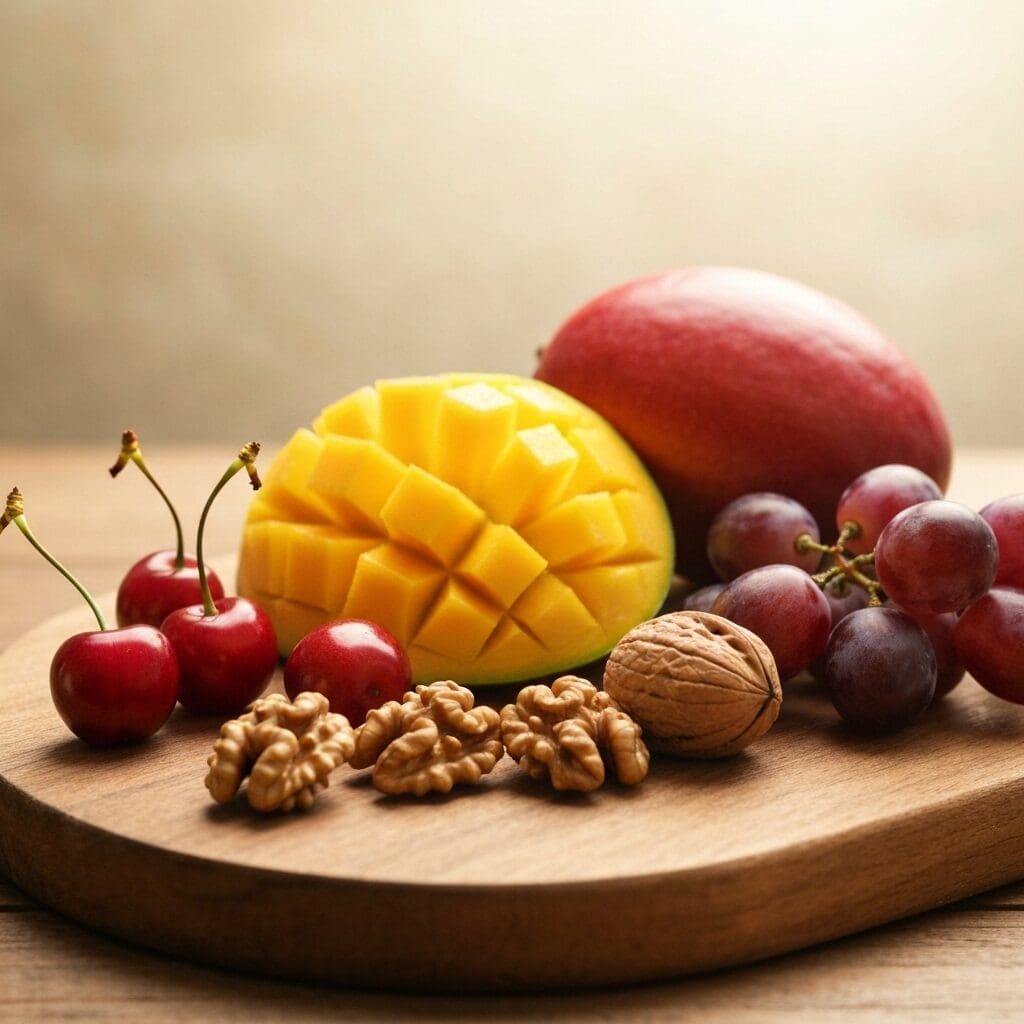Kale Pomegranate & Butternut Squash Salad: A Registered Dietitian’s Guide to Vibrant Winter Eating

As the days grow shorter and the air turns crisp, our bodies often crave nourishing, vibrant meals that truly satisfy. This Kale Pomegranate Salad with Butternut Squash & Apple is precisely that—a celebration of seasonal ingredients packed with flavor, texture, and a wealth of health benefits.
Crafted with insights from a Registered Dietitian, this recipe goes beyond just ingredients, offering practical tips for preparation, maximizing nutrient absorption, and customizing it to fit your lifestyle. Get ready to enjoy a salad that’s as beautiful as it is beneficial, perfect for a cozy weeknight or a festive gathering.
- Why This Vibrant Salad Is Your New Winter Go-To
- Mastering the Art of Tender Kale: The Essential Massage
- Pomegranate Perfection: Deseeding Without the Mess
- Building Your Bowl: The Health Benefits of Each Star Ingredient
- Speedy Salad Solutions: Smart Shortcuts for Busy Lives
- Step-by-Step Assembly: Your Kale Pomegranate Salad Recipe
- Making It a Complete Meal: Pairing & Customization Ideas
- Storing Your Delicious Salad for Optimal Freshness
- Conclusion
Why This Vibrant Salad Is Your New Winter Go-To

This isn’t just any salad; it’s a nutritional powerhouse disguised as a simple, delicious meal. Here’s why this kale pomegranate salad will become a staple in your fall and winter rotation:
- Antioxidant Abundance: Pomegranates are renowned for their high levels of antioxidants, particularly polyphenols, which help combat oxidative stress in the body. Kale and butternut squash further boost this protective capacity, according to scientific reviews.
- Fiber-Rich Goodness: With kale, butternut squash, apples, and pomegranates, this salad is loaded with dietary fiber. Fiber is crucial for digestive health, helps regulate blood sugar, and promotes a feeling of fullness, aiding in weight management, as supported by numerous studies.
- Immune System Support: The vitamin C from kale and apples, along with Vitamin A from butternut squash, play vital roles in supporting a robust immune system, particularly important during colder months, a fact highlighted by the National Institutes of Health.
- Heart-Healthy Fats: The olive oil in the dressing and the pecans contribute monounsaturated and polyunsaturated fats, which are beneficial for cardiovascular health and can help reduce bad cholesterol levels, an approach central to many healthy eating patterns like the Mediterranean diet.
- Effortlessly Elegant: Despite its sophisticated appearance, this salad is surprisingly easy to prepare. It’s perfect for impressing guests at a holiday meal or simply elevating your everyday lunch.
Mastering the Art of Tender Kale: The Essential Massage

If you’ve ever found kale salads tough or bitter, the secret to tender, palatable greens lies in a simple technique: massaging the kale. This isn’t just a culinary quirk; there’s a scientific reason it works wonders.
Why Massage Kale?
Kale’s leaves contain tough cellulose fibers, which contribute to its chewy texture. Massaging the kale with a little olive oil and acidity (like lemon juice or vinegar from the dressing) helps to physically break down these fibers, softening the leaves and making them more palatable. It also helps to “predigest” the kale slightly, making it easier for your body to absorb its nutrients.
How to Massage Kale Perfectly:
- Prep Your Kale: Start with washed and thoroughly dried kale leaves, stems removed, and chopped into bite-sized pieces. Place them in a large mixing bowl.
- Add a Little Fat: Drizzle about 1 tablespoon of olive oil over the kale. You can also add a pinch of salt.
- Get Hands-On: Using clean hands, gently but firmly rub and squeeze the kale leaves for about 1-2 minutes. You’ll notice the kale transform from bright green and stiff to a darker, softer, and slightly wilted appearance.
This simple step ensures your salad base is tender, flavorful, and ready to soak up all the delicious dressing without feeling like a chore to chew!
Pomegranate Perfection: Deseeding Without the Mess

The vibrant, jewel-like arils (seeds) of a pomegranate add a burst of sweet-tart flavor and incredible texture to this salad. However, getting them out can seem daunting. Forget the messy splatters; this underwater method is a game-changer for clean and efficient deseeding.
Choosing Your Pomegranate
Look for pomegranates that are heavy for their size, with taut, unblemished skin. A slightly squared-off shape can indicate well-developed arils inside.
The Mess-Free Method:
- Fill a Bowl with Water: Grab a large bowl and fill it with enough water to comfortably submerge half a pomegranate. The water acts as a barrier, catching any juice and separating the arils.
- Gentle Slice & Break: Carefully score the pomegranate around its equator, but don’t cut all the way through. Gently break it open into two halves with your hands. You can then break these halves into 3-4 smaller sections if needed.
- Submerge and Release: Place the pomegranate pieces into the water. Underneath the water, gently use your fingers to pry the arils from the white membrane and peel. The arils will sink to the bottom, while the lighter pith and membrane will float.
- Drain and Enjoy: Once all the arils are released, skim off the floating bits of membrane. Drain the water through a colander, and you’re left with perfectly clean, ready-to-use pomegranate arils!
Building Your Bowl: The Health Benefits of Each Star Ingredient

Every ingredient in this salad plays a role in both flavor and nutrition, making it a truly wholesome meal. Let’s explore the goodness packed into your bowl:
- Kale (The Leafy Green King): A cruciferous superstar, kale is loaded with Vitamins K, A, and C, as well as manganese and powerful antioxidants like quercetin and kaempferol. It supports bone health, vision, and immune function, as detailed by the USDA FoodData Central.
- Pomegranate (The Jewel of Winter): Beyond its stunning appearance, pomegranate is rich in punicalagins, unique antioxidants that may have anti-inflammatory effects and protect against heart disease, according to extensive research.
- Butternut Squash (The Sweet & Creamy Base): This vibrant orange squash is an excellent source of beta-carotene, which converts to Vitamin A in the body, essential for vision, skin health, and immune support. It also provides a good dose of fiber and Vitamin C, based on data from the USDA.
- Apple (The Crisp Sweetener): Apples contribute natural sweetness, satisfying crunch, and soluble fiber (pectin), which can help regulate digestion and blood sugar levels. They also contain various antioxidants, per nutritional information from the USDA.
- Pecans (The Healthy Crunch): These buttery nuts offer healthy monounsaturated fats, fiber, and important minerals like zinc and magnesium. They add a delightful texture contrast and contribute to satiety, as outlined in the USDA FoodData Central database.
- Homemade Vinaigrette (The Flavor Unifier): Made with extra virgin olive oil (healthy fats), lemon juice (Vitamin C, brightens flavors), white balsamic vinegar (tang), honey (natural sweetness), and Dijon mustard (emulsifier, savory notes), this dressing ties all the components together beautifully, enhancing both taste and nutrient absorption.
Speedy Salad Solutions: Smart Shortcuts for Busy Lives

In our fast-paced lives, convenience often dictates our food choices. But “convenience” doesn’t have to mean sacrificing nutrition. For this salad, there are several smart shortcuts you can take without compromising on quality or health benefits.
- Pre-Cut Butternut Squash: Peeling and dicing a whole butternut squash can be time-consuming. Opt for pre-cut, fresh butternut squash from the produce section. It’s a huge time-saver and equally nutritious.
- Pre-Washed & Chopped Kale: Bags of pre-washed and sometimes pre-chopped kale are readily available. This eliminates a significant prep step, making your salad assembly much quicker.
- Pre-Seeded Pomegranate Arils: While fresh is always wonderful, containers of ready-to-eat pomegranate arils are a fantastic option when you’re short on time. They still deliver the same great taste and nutritional punch.
Remember, choosing these convenience items isn’t being “lazy”; it’s being realistic about fitting healthy eating into a busy schedule. Prioritizing your health with smart choices is always a win!
Step-by-Step Assembly: Your Kale Pomegranate Salad Recipe

Here’s how to bring all these wonderful ingredients together for a truly exceptional salad:
Prep Time: 20 minutes
Cook Time: 25-30 minutes (for squash)
Servings: 4
Ingredients:
- Salad Base:
- 1 large bunch of kale, stems removed, chopped (or 12 oz bag pre-washed)
- 1 tbsp extra virgin olive oil (for kale massage)
- 1/2 medium red onion, thinly sliced
- 1 large apple (e.g., Honeycrisp, Fuji), thinly sliced
- 1 whole pomegranate, seeded (or 1 cup pre-seeded arils)
- 1 cup roasted butternut squash, cubed (see note below for roasting)
- 1/2 cup pecans, lightly toasted (optional)
- Maple-Dijon Vinaigrette:
- Juice of 1 medium lemon (approx. 2-3 tbsp)
- 3 tbsp extra virgin olive oil
- 2 tbsp white balsamic vinegar
- 1 tbsp pure maple syrup (or honey)
- 1 tbsp Dijon mustard
- Salt and freshly ground black pepper to taste
Instructions:
- Roast Butternut Squash: Preheat oven to 400°F (200°C). Toss butternut squash cubes with a drizzle of olive oil, salt, and pepper on a baking sheet. Roast for 25-30 minutes, or until tender and lightly caramelized. Set aside to cool slightly.
- Make the Vinaigrette: In a small bowl or jar, combine lemon juice, olive oil, white balsamic vinegar, maple syrup (or honey), and Dijon mustard. Whisk vigorously or shake until well combined and emulsified. Taste and adjust seasoning with salt and pepper.
- Massage the Kale: In a large mixing bowl, combine the chopped kale and 1 tablespoon of olive oil. Using clean hands, gently massage the kale for about 1-2 minutes until it softens and turns a darker green.
- Combine Ingredients: Add the pomegranate arils, sliced apple, and thinly sliced red onion to the bowl with the massaged kale.
- Dress the Salad: Pour the vinaigrette over the salad ingredients. Toss gently to ensure everything is evenly coated.
- Add Final Touches: Just before serving, gently fold in the roasted butternut squash and toasted pecans. This prevents the squash from breaking down and the pecans from getting soggy. Serve immediately and enjoy!
Making It a Complete Meal: Pairing & Customization Ideas

While this salad is wonderfully satisfying on its own, it’s also incredibly versatile. As a Registered Dietitian, I often recommend adding a lean protein to create a more balanced and filling meal. Here are some ideas to make this salad your own:
Protein Power-Ups:
- Grilled Chicken or Turkey: Lean poultry is a classic choice. Slice it thinly and arrange it over the salad.
- Pan-Seared Salmon or Shrimp: Adds omega-3 fatty acids and a delicious seafood twist, which is a key component for anyone looking to embrace a healthier diet.
- Chickpeas or Lentils: For a plant-based option, roasted chickpeas or cooked lentils provide an excellent source of protein and fiber.
- Hard-Boiled Eggs: A quick and easy protein boost.
- Halloumi Cheese: Grilled or pan-fried halloumi adds a salty, savory element and satisfying texture.
Flavor & Texture Boosters:
- Cheese: Crumbled feta, goat cheese, or blue cheese can add a tangy, creamy dimension.
- Other Nuts & Seeds: Walnuts, sunflower seeds, pumpkin seeds, or even candied pecans can replace or complement the plain pecans.
- Roasted Vegetables: Instead of butternut squash, try roasted sweet potatoes, Brussels sprouts, or even cauliflower for different flavor profiles.
- Seasonal Fruit Swaps: In warmer months, swap the apples for sliced peaches, nectarines, or even fresh figs for a summery twist.
Serving Suggestions:
- Serve as a vibrant side dish to roasted chicken, fish, or a hearty vegetarian stew.
- Pair with a whole-grain crusty bread or a warm bowl of lentil soup for a comforting meal.
Storing Your Delicious Salad for Optimal Freshness

Meal prepping and proper storage are key to enjoying this salad throughout the week. To maintain its vibrant texture and flavor, a little strategic planning goes a long way.
General Storage Tips:
- Keep Dressing Separate: Always store the vinaigrette in an airtight container or jar separately from the salad ingredients. This prevents the greens from getting soggy.
- Layering for Freshness: If you’re assembling for later, consider layering your salad components. Start with heartier vegetables (like butternut squash) at the bottom, then kale, followed by apples, pomegranate arils, and red onion on top. This protects the more delicate ingredients.
- Add “Wet” Ingredients Last: If you are adding ingredients like avocado or certain cheeses that can brown or wilt, add them just before serving.
- Crunchy Toppings: Nuts like pecans should be stored separately and added right before serving to maintain their crispness and prevent them from becoming soggy.
When stored properly in airtight containers in the refrigerator, the undressed salad components can last for 3-4 days. Dress individual servings as you’re ready to eat!
Conclusion
This Kale Pomegranate Salad with Butternut Squash & Apple is more than just a recipe; it’s an invitation to embrace flavorful, nutrient-dense eating that supports your well-being. By incorporating seasonal ingredients and smart preparation techniques, you can create a dish that’s both effortlessly elegant and deeply satisfying.
From the antioxidant power of pomegranates to the gut-friendly fiber in kale and squash, every bite contributes to your health. Enjoy this vibrant salad as a simple weeknight dinner, a festive holiday side, or a delicious meal prep option to fuel your body with goodness all week long.
